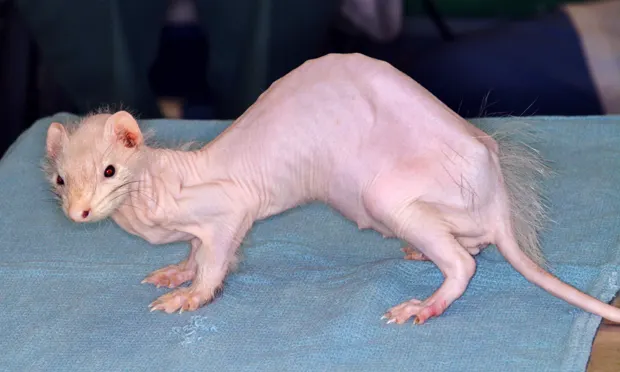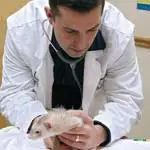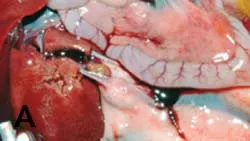Adrenal Gland Disease in Ferrets

ProfileOverview
Veterinarians have treated pet ferrets for over 30 years, leading to a better understanding of the diagnostic differentials associated with common signs.
Ferrets with adrenal gland disease have a normal history until signs appear.
One of the most common signs of adrenal gland disease in pet ferrets is alopecia.
Signalment and clinical signs aid in the diagnosis of this disease.
Adrenal gland disease in ferrets is distinguished from Cushing’s disease in dogs by signs and pathophysiology.
One or both adrenal glands may be affected.
Pituitary or hypothalamic involvement is not reported.
Pathology varies from benign hyperplasia to adenoma to carcinoma.
On average, the disease is first recognized around 3 years of age.1
There is no known sex predilection.1
Based on the author’s clinical experience and reports from colleagues, this disease may affect up to 50% of pet ferrets in the United States.
Causes
Although there is still speculation as to the cause of adrenal gland disease in ferrets, some likely theories have been suggested and investigated.2
Recent research gives credence to the theory that neutering destroys the negative feedback mechanism that keeps the release of luteinizing and follicle-stimulating hormones in check.
After a ferret is neutered, this mechanism is interrupted and increased concentrations of compounds induce pathologic changes in the adrenal glands, potentially leading to adrenal gland disease. ther theories include genetic predisposition or exposure to abnormal light cycles leading to abnormal melatonin concentrations.
Signs
Common signs include alopecia, vulvar enlargement, pruritus, and sexual aggression.
Alopecia typically originates near the proximal tail and progresses distally; it extends along the flanks and ventrum, eventually involving the dorsum.
Female ferrets commonly exhibit an enlarged vulva, occasionally accompanied by inflammatory discharge.
Pruritus is commonly reported in both male and female ferrets. Shampoos, other dermatologic preparations, and antiinflammatory medications are ineffective for adrenal gland–induced pruritus.
Behavior suggestive of sexual aggression includes biting the back of another ferret (eg, to drag it) or biting at the owner’s ankles.
In male ferrets, prostatic tissue infrequently may become enlarged and cystic as a result of the hormones produced by the adrenal gland.
An enlarged prostate can impinge on the urethra, leading to stranguria or dysuria that, if untreated, can result in total urinary blockage and subsequent metabolic derangements.
A rare manifestation of this disease is bone marrow suppression leading to anemia and potentially leukopenia and thrombocytopenia.
On Examination
Pruritic ferrets may exhibit erythema secondary to scratching. This is observed most commonly on the skin between the shoulder blades.
The spleen may be enlarged.
Enlarged spleen in older ferrets is a common finding but is not known to be associated with adrenal gland disease.
An enlarged adrenal gland (uncommon) may be palpable.
Pain Index
Adrenal gland disease is not associated with pain except when male ferrets are unable to urinate.
In such cases, the pain index can be rather high; urethral patency must be restored and pain medication must be administered.

DiagnosisDefinitive Diagnosis
Although a diagnosis can be made from signalment and examination, definitive diagnosis is best supported with abdominal ultrasonography, laboratory results, and histopathology.
Differential Diagnosis
Few other diseases in ferrets have signs that include symmetric alopecia and vulvar enlargement.
Ectoparasites (fleas), dermatophytosis, and bacterial skin infections may cause alopecia, but not typically in a symmetric pattern.
An enlarged vulva and some hair loss can be present in intact ferrets or those with an ovarian remnant.
Intact females will typically exhibit estrus, including enlarged vulva, during their first spring.
Most affected ferrets are middle-aged, and signalment can indicate whether the vulva is enlarged because the ferret is intact.
An ovarian remnant can cause vulvar enlargement in older patients but is an uncommon diagnosis, at least in the United States. Imaging diagnostics and blood tests can help differentiate the two.
DiagnosticsLaboratory Findings
In most ferrets with adrenal gland disease, both CBC and plasma biochemistry profile values are within normal limits.
Rare exceptions occur with suppression of bone marrow, resulting in anemia.
Anemia is usually seen before leukopenia or thrombocytopenia develops and is likely caused by the type and quantity of estrogen production.
Ferrets with prostatic disease may have an increased WBC count as a result of secondary urinary tract infection.
Imaging
In most instances, radiography does not confirm enlarged or abnormal adrenal glands.
Abdominal ultrasonography in the hands of an experienced operator can identify abnormal (eg, size, architecture) or deranged adrenal gland(s).
Prostatic enlargement can also be seen on radiographs and ultrasound.
Other
Measurement of abnormally elevated compounds (ie, estrogen, 17-OH progesterone, androstenedione) is the definitive diagnostic test other than histopathology of adrenal gland tissue.
Presence of one or more of these hormones in neutered ferrets can be an excellent indicator of adrenal gland disease, especially in conjunction with signs.
TreatmentWhy & When to Refer
Medical treatment and monitoring are generally accomplished by general practitioners.
Referral should be considered if the practitioner does not feel comfortable performing venipuncture or other procedures on ferrets. Referral should also be considered if surgical treatment is beyond the practitioner’s experience.
Medical TherapyDrugs/Fluids
Drug therapy can only alleviate clinical signs. At present, there are no preparations that destroy abnormal adrenal gland tissue.
GnRH agonists include leuprolide acetate (Lupron, lupron.com) started at a dose of 100 µg/kg (SC or IM) q30 days—these are long-acting injectable depots.
Deslorelin, another GnRH agonist, is currently difficult to obtain in the United States.
An injectable depot form of melatonin that is available (Ferretonin, melatek.net) as oral dosing appears ineffective for relieving clinical signs.
Other treatment options: anastrozole at 0.1 mg/kg PO q24h or flutamide at 10 mg/kg PO q12–24h.
Precautions & Contraindications
Melatonin can dangerously lower the endogenous blood glucose concentration and may be contraindicated in ferrets with insulinoma.
Owners should be advised that medications do not cure the disease—they only control signs.

Surgery
Surgical removal of one or both adrenal glands (Figure 1. Right adrenal gland and vena cava; A and B) is the only potential curative treatment.
In patients with prostatic disease, surgery is usually required to decrease the size of the prostate.
Working with the Specialist
Report the previously performed diagnostics so they are not repeated.
Provide a list of the patient’s recent medications.
Ask for a surgical report detailing what was removed and submitted for histopathology.
Follow-UpPatient Monitoring
Signs must be monitored; in most ferrets, this is accomplished by observing changes in hair growth and vulvar size.
The general health of medicated patients must be monitored with plasma biochemistry profile and CBC.
Prognosis
Prognosis is variable.
Ferrets demonstrating solely cosmetic signs of disease, uncomplicated adrenal gland disease in female ferrets, and complete successful surgeries likely have good prognoses and normal lifespans.
Ferrets with incomplete adrenal gland resections may sustain relapses within months to years.
Ferrets with prostatic disease can have a good prognosis if the diseased adrenal gland(s) is removed (prostate returns to normal size).
Complications
In ferrets with bone marrow suppression or prostatic disease, complications from secondary conditions can develop.
Surgical complications include incomplete excision, damage to the vena cava (leading to altered blood flow), hypertension, ascites, and renal damage.
At-Home Treatment
With surgery or long-acting depot treatment, patients do not need any at-home treatment; immediately after surgery, however, pain medication may be necessary.
Of note, older ferrets may also have other diseases (eg, insulinoma, heart disease).
Species at a Glance
Adrenal gland disease in ferrets is common.
Alopecia, vulvar enlargement, pruritus, and sexual behavior are the most common signs, followed by stranguria (very uncommon) and/or anemia (rare).
Life-threatening conditions are uncommon to rare.
Ferrets can be treated medically to lessen the signs of disease.
Surgery can be curative and is best performed in the hands of a surgeon familiar with ferret anatomy.
KAREN ROSENTHAL, DVM, MS, is dean and professor of exotic animal medicine at St. Matthew’s School of Veterinary Medicine. Dr. Rosenthal has a broad range of interests and speaks and writes on topics concerning small mammals, birds, and reptiles. In 2010, she was named Exotic DVM of the Year by Exotic DVM veterinary magazine. She has spoken at the NAVC Conference every year since 1983 and has presented at the NAVC Institute. Dr. Rosenthal obtained her DVM from North Carolina State University.